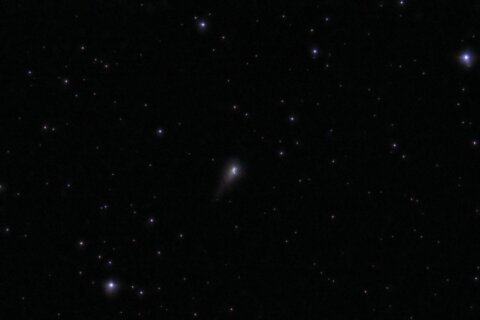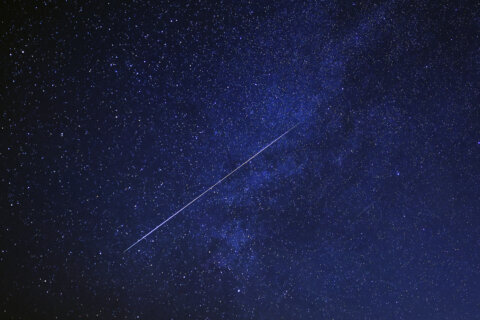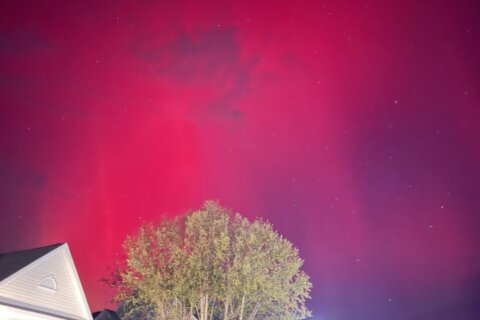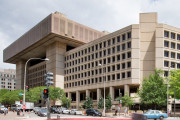This video is no longer available.
“What’s up in the sky?” is a recurring feature and publishes on the first of every month. You can find it on WTOP’s The Space Place. Email Greg your space questions and he might answer them in the next edition.
Welcome to WTOP’s inaugural monthly feature of “What’s up in the sky?” Each month will feature the best the sky has to offer stargazers regarding the moon, planets and stars and space-related events that might interest you taking place in the D.C. region will be included as well.
Maybe you got lucky with Santa and you have new binoculars, an astronomy app and/or telescope to usher in a year of stargazing. If not, it is never too late to get equipped!
Let’s get to the sky for January 2025!
The internet has headlines about what is being hailed as a rare “January 25 parade of planet.” The online stories are full of hype and inaccuracies and some even focus more on astrology than astronomy.
The real deal is that January 2025 is a very exciting month and start to the New Year for stargazers.
Must-see sky sights for January
The bright and glorious constellations of winter will greet you as soon as it gets dark. Take some time to find Orion the Hunter, Taurus the Bull, Gemini the Twins and others.
Jan. 2-3: Quadrantid Meteor Shower
Jan. 3: The crescent moon and bright Venus pair up in the Southwestern sky at dusk. Look for Earthshine on the moon.
Jan. 4: The waxing crescent moon and Saturn pair up high in the Southwestern sky at dusk
Jan. 9: The waxing gibbous moon is in the Pleiades Star Cluster. Binoculars are recommended to see this one.
Jan. 10: The waxing gibbous moon and Jupiter pair up high in the East.
Jan. 12: Mars is closest to Earth 9 a.m. at 59,703,891 miles.
Jan. 13-14: This is the highlight of the month as the moon occults (covers) Mars. Check the list to see the closest city to your location. Be outside before the time listed. Binoculars and telescopes are ideal for this event. Mars disappears at 9:16 p.m. in D.C. and reappears at 10:30 p.m.
Jan. 15-16: Mars is at opposition in the Eastern sky at sunset and visible all night.
Jan. 17: Venus pairs up with Saturn in the Southwestern sky at dusk.
Jan. 17: Bright and reddish-orange Mars lines up with the two brightest stars in Gemini, the Twins — Castor and Pollux — for an eye catching sight of the three of them in a line in the East.
Jan. 31: The waxing crescent moon will be to the lower right of Saturn with Venus above at dusk.
Jan. 31: Once again Mars and the two brightest stars in Gemini, the Twins — Castor and Pollux — join up, this time for an impressive triangle formed by the three of them in the East.
The moon
Jan. 6: First quarter
Jan. 13: January’s full moon is called the full wolf moon
Jan. 21: Last quarter
Jan. 29: New moon
The planets
In January, Mercury is low in the Southeast sky about an hour before sunrise and binoculars will help immensely to find the bright yellowish planet.
Venus blazes above the southwest horizon as it gets dark, you can’t miss it.
Earth is at perihelion (closest to the Sun for the year) on Jan. 4 at 8 a.m. 147,103,686 km.
Mars is closest to the Earth and at its brightest this month and is quite the sight. Mars rises in the East at 8 p.m. as the month begins but reaches opposition, which is directly opposite the Sun and rising at sunset on Jan. 15. In a small telescope some surface features can be spotted and identified with this nifty tool.
Jupiter is bright and located high in the sky all month, only the moon and Venus are brighter than the king of the planets. A pair of 7×50 binoculars will show the four main moons of Jupiter looking like “stars” in a line which constantly changes. You can identify the moons by using this link. A small telescope can reveal features in Jupiter’s atmosphere.
Saturn is high in the southwestern sky. A small telescope will show that Saturn’s rings are currently almost edge on, which is quite the sight.
Uranus can be spotted with binoculars using this star chart to locate it. In small telescopes you can detect the color of the planet but not much else.
Neptune needs a telescope to be viewed and it is worth seeing its deep blue color.
Pluto is way out there in the solar system and requires taking images through a telescope spaced days apart to hunt it down.
DC-area events
January events at Virginia State Parks can be found here.
The NOVAC General Meeting will be at George Mason University at 7:30 p.m. on Jan. 12.
The National Capital Astronomers will have its meeting at 7 p.m. on Jan. 11. The topic will be “On the Trail of the Missing Galaxies: The Oldest Stars in the Neighborhood” and will be led by Thomas Brown (STScI), On the Trail of the Missing Galaxies: The Oldest Stars in the Neighborhood.
The Analemma Society will be holding Friday Night Public Viewing Sessions at Observatory Park at Turner Farm in Great Falls, Virginia, from 7:30-9:30 p.m.
The Smithsonian Air & Space in D.C. and Chantilly has a lot of astronomy-related stuff in January.
You can check here and here for astronomy clubs that are outside the DMV.
Added bonus
Download NASA’s 2025 Science calendar, which features out of this world pictures and information.
The Planetary Society’s Space Events 2025 Calendar is another resource for tracking space missions.
Use this useful tool to create a custom star chart for your location to help you find your way around the stars.
You can also send in any space related questions to my email address. Suggestions about this feature are also welcome.
You are starting off 2025 right by enjoying the beauty and serenity of the night sky … and you will be glad you did.
Follow Greg Redfern on Facebook, Bluesky and his daily blog to keep up with the latest news in astronomy and space exploration.
Get breaking news and daily headlines delivered to your email inbox by signing up here.
© 2025 WTOP. All Rights Reserved. This website is not intended for users located within the European Economic Area.







